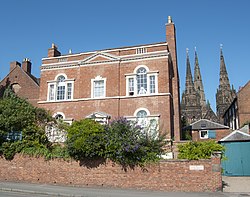Erasmus Darwin House
| Erasmus Darwin House | |
|---|---|

Front of the house
|
|
| General information | |
| Address | Beacon Street, Lichfield, Staffordshire, England |
| Coordinates | 52°41′7.25″N 1°49′59.25″W / 52.6853472°N 1.8331250°WCoordinates: 52°41′7.25″N 1°49′59.25″W / 52.6853472°N 1.8331250°W |
| Website | |
| www |
|
Erasmus Darwin House in Lichfield, Staffordshire is the former home of the English poet and physician Erasmus Darwin, grandfather of naturalist Charles Darwin. The house is a Grade I listed building, and is now a writer's house museum commemorating Erasmus Darwin's life.
Erasmus Darwin, the renowned physician, scientist, inventor, poet, and educationalist lived on Beacon Street from 1758 until 1781. A founding member of the Lunar Society, it was here that he received many famous 18th-century personalities, including Josiah Wedgwood, Matthew Boulton, Benjamin Franklin and James Watt.
Darwin purchased a medieval half-timbered building on the west side of the lower courtyard of the Vicars Choral in 1758. From 1758-1759 Darwin converted the building into a large Georgian town house of red brick with stucco dressings and Venetian windows. At this time the front of the house was separated from Beacon Street by a narrow deep ditch which once formed the moat of the Cathedral Close. Darwin built a bridge across the ditch descending from his hall door to the street. The ditch was overgrown with tangled bushes, which Darwin cleared and made a terrace on the bank. He planted the ditch with lilacs and rose bushes which screened his terrace from passers by. After Darwin left in 1781 the next owner filled in the ditch to make a driveway from the street to his doorway.
Not long after the Darwins moved into the fashionable new front of their house, a wooden bridge was thrown across the ditch and a twin-tier terrace was built, causing alterations to be made to the basement windows. Anna Seward recollected that the bridge and terrace both had Chinese pailings.
For 20 years this house was the base for Darwin's medical practice, for his scientific experiments, meetings of the Lunar Society, and such inventive schemes as the construction of the Trent and Mersey Canal. Amid all this, the house was also the centre of family life.
...
Wikipedia
